


 4:16:2
4:16:2  2019-07-30
2019-07-30  936
936

Some researchers hope to find the secret of keeping old age at bay and enjoying eternal youth instead. However, a team of scientists from Southern California is looking for a different "recipe" — that of better aging.
"To drink from the fountain of youth, you have to figure out where the fountain of youth is and understand what the fountain of youth is doing," says Nick Graham, who is an assistant professor in the Mork Family Department of Chemical Engineering & Materials Science at the University of Southern California (USC) Viterbi School of Engineering in Los Angeles.
However, this is not what Graham and his colleague from USC are trying to achieve. As Graham himself notes: "We're doing the opposite; we're trying to study the reasons cells age so that we might be able to design treatments for better aging."
In a study whose findings they have recently published in the Journal of Biological Chemistry, Graham and team have taken a more in-depth look at what happens to cells going through the process of senescence — the stage of cell life at which they no longer divide.
"Senescent cells are effectively the opposite of stem cells, which have an unlimited potential for self-renewal or division," explains the study's lead author, USC doctoral student Alireza Delfarah.
"Senescent cells can never divide again. It's an irreversible state of cell cycle arrest," Delfarah notes.
Cellular senescence is a key part of a body's age-related decline, and many scientists have studied this process. Most research focuses on senescence in fibroblasts, a type of cells widely present in connective tissue. However, this team chose to analyze senescence in epithelial cells.
These cells are present in the tissue at the very surface of organs and other types of tissue in the body. They are also the type of cells in which most forms of cancer start.
Understanding a complex aging process
In the current study, the researchers first looked at young epithelial cells, feeding them molecules that they chemically labeled. This labeling enabled them to see how the cells processed the nutrients they consumed.
Eventually, the team saw that as they reached senescence, the cells stopped producing nucleotides, organic molecules that are the main components of DNA.
The researchers then experimented with young cells by artificially halting their nucleotide production. When they did this, they found that the cells immediately entered the senescence stage.
"This means that the production of nucleotides is essential to keep cells young," explains Delfarah.
However, he adds, "[i]t also means that if we could prevent cells from losing nucleotide synthesis, the cells might age more slowly."
When the team developed 3D images of the senescent cells, it found another surprise — namely that these cells often had not one, but two nuclei (cellular centers), and they were unable to synthesize DNA.
All these findings taken together may help the researchers find better ways of stopping senescence. However, this approach could be tricky because, although it contributes to age-related decline, cellular senescence is also a protective mechanism that can prevent cancer from developing.
"Sometimes people talk about senescence as a double-edged sword; that it protects against cancer, and that's a good thing. But then it also promotes aging and diseases like diabetes, cardiac dysfunction or atherosclerosis, and general tissue dysfunction," notes Graham.
Graham continues, "we would like to find a way to remove senescent cells to promote healthy aging and better function."
'Targeted therapeutics' against aging cells
The team hopes that the current findings could contribute to the development of senolytic drugs in the future. Senolyitics are a class of drugs that could remove aging cells and help promote a healthier life well into old age.
Existing research has already started testing senolytics in mouse models, and there are even some early clinical trials underway.
"[Researchers] can take a mouse that's aging and diminishing in function and give it these senolytic drugs to eliminate the senescent cells, and the mouse is rejuvenated. So if anything, it's these senolytic drugs that are the fountain of youth," says Graham.
Yet, he notes, for these drugs to be effective and not harm humans, researchers have to understand how senescent cells differ from young ones so that the drugs will not mistakenly eliminate healthy, non-senescent cells.
"That's where we're coming in—studying senescent cell metabolism and trying to figure out how the senescent cells are unique so that you could design targeted therapeutics around these metabolic pathways." Nick Graham
Reality Of Islam |
|

For years,

New scienti

This is the

A computer
 9:3:43
9:3:43
 2018-11-05
2018-11-05
10 benefits of Marriage in Islam
 7:5:22
7:5:22
 2019-04-08
2019-04-08
benefits of reciting surat yunus, hud &
 9:45:7
9:45:7
 2018-12-24
2018-12-24
advantages & disadvantages of divorce
 11:35:12
11:35:12
 2018-06-10
2018-06-10
 6:0:51
6:0:51
 2018-10-16
2018-10-16
 9:30:2
9:30:2
 2021-11-12
2021-11-12
 8:39:51
8:39:51
 2022-09-23
2022-09-23
 5:58:12
5:58:12
 2021-12-18
2021-12-18
 6:28:21
6:28:21
 2022-12-20
2022-12-20
 2:34:48
2:34:48
 2022-01-18
2022-01-18
 7:32:24
7:32:24
 2022-02-14
2022-02-14
 12:10:56
12:10:56
 2022-11-17
2022-11-17
 5:41:46
5:41:46
 2023-03-18
2023-03-18
| LATEST |